It’s October 27, 2020, and Australia’s celebrity cosmetic surgeon and global TikTok sensation Dr Daniel Lanzer is highly agitated. His nurses have failed him, yet again. They need reminding of his doctrine.
“Never, ever, ever, not slightly ever, ever, ever, ever, ever, ever, EVER admit to a patient that something’s bad or wrong,” Dr Lanzer bellows in an audio message to his 60 staff scattered around the country and in the Philippines. “They’ll use it against you 100 times for the rest of your life.”
With a major presence on television, millions of followers on Instagram and TikTok and a multimillion-dollar net worth, Dr Lanzer is undoubtedly Australia’s highest-profile cosmetic surgeon. His network of practices conduct thousands of procedures a year, including facelifts, tummy tucks, liposuction and Brazilian butt lifts.
But while Dr Lanzer’s extensive public presence depicts a fun and caring cosmetic surgeon who wants to make Australians feel better about themselves, former staff members, medical experts and patients present a markedly different picture.
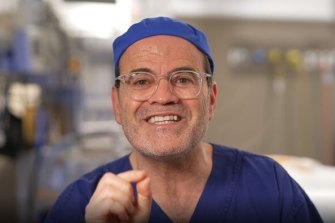
Cosmetic surgeon Daniel Lanzer.
“You never tell a patient ‘you’re infected’, no …” Dr Lanzer says in an audio message to staff in October 2020. “You never tell a patient ‘you haven’t got gowns, gloves, this that’, no! … You do not own up to nothing! Zero! … Never, ever, ever, ever own up to anything.”
A joint Sydney Morning Herald, The Age and ABC Four Corners investigation has uncovered a litany of troubling practices across Dr Lanzer’s network, including serious hygiene and safety breaches, and examples of botched procedures that have left patients in extreme pain and requiring further medical treatment.
Whistleblowers and former patients describe Dr Lanzer’s clinics as chaotic places that “set off alarm bells”.

Whistleblower Lauren Hewish.Credit:Simon Schluter
“People are just pushed in and out, blood everywhere, fat everywhere,” says nurse Lauren Hewish, who worked for Dr Lanzer for 18 months and left the business in April.
“It’s absolutely chaos,” says nurse Justin Nixon, who resigned in July 2020 after also working for Dr Lanzer for 18 months.
“Multiple surgeries running throughout the day, doctors going from room to room. It’s just bloody, messy, gruesome.”
Dr Lanzer says he has thousands of happy patients. But one former patient, Kathy Hubble, said she ended up in hospital for almost a week after developing a serious infection, cellulitis, shortly after attending Dr Lanzer’s clinic in November 2018 for liposuction procedures on her legs and abdomen. “It got to the point where I couldn’t sit, I couldn’t stand, I couldn’t lie down,” she said. “I’ve never had such agony in all my life.”
Ms Hubble’s partner rushed her to Gosford Hospital, close to where she lives. “A couple of doctors looked at me, and they were absolutely horrified,” she said.
Another patient, a Victorian policewoman who requested anonymity for professional reasons, says Dr Lanzer did a tummy tuck on her that required corrective surgery.
“I had to have labiaplasty because he had pulled the bottom of my stomach up so tight that it was then uncomfortable for me in my labia area,” she said. Her belly button was put back off-centre and was too small, which she says made it difficult to properly clean.
Other allegations of questionable conduct uncovered by the investigation include:
- A dangerous lack of care while performing liposuction.
- The use of staples in front of the ear in a facelift procedure, which has been described by three specialist plastic surgeons as unusual and scarring.
- The removal of 10 litres of fat and fluids from liposuction patients in one procedure, which is considered dangerous and twice the amount considered safe.
- Staff being asked to store human fat in their fridges at home to avoid questions from regulators during an inspection.
- Nurses using expired medication on some patients.
One video shows Dr Lanzer’s staff and contractors dancing and singing while performing liposuction procedures on an unconscious patient. In the recording, two doctors laugh and dance to Dolly Parton’s Jolene as they thrust long stainless-steel cannulas into an unconscious male patient, as if to the beat.
The video, taken last October, was shown to three specialist plastic surgeons for their expert opinions. One of them, Mark Ashton, a professor of surgery at the University of Melbourne and the former president of the Australian Society of Plastic Surgeons, says it’s dangerous and disrespectful.
“If you didn’t show me these people, you’d think, ‘Oh, this can’t be happening in Australia.’ Where have we gone so wrong in Australia that these two individuals think that this is acceptable?”
Professor Ashton says if the tip of a cannula lacerates a patient’s spleen, bowel or liver, it can cause serious medial issues.
“These two gentlemen are not even watching where the tip of the cannula is going.”
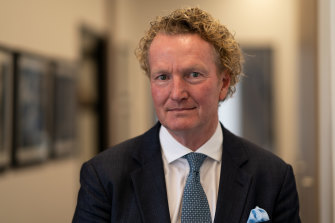
Professor of Surgery at the University of Melbourne, Mark Ashton.Credit:Andy Ware
Dr Lanzer said in a statement that he reprimanded the staff involved in this incident. He also stated that the man dancing in the video was not working for him, and the video was not posted publicly on social media.
In another video, while Dr Lanzer is performing liposuction on a patient, he reprimands staff for not picking up the phone enough.
“I saw Dr Lanzer talk to the camera then, he didn’t have any idea where the tip of that cannula was,” Professor Ashton said.
‘Like the Wild West without the sheriffs’
Daniel Lanzer is a qualified dermatologist, but over the past three decades he has forged a lucrative career in the fast-growing field of cosmetic surgery.
Australians now spend an estimated $1 billion on cosmetic surgery procedures each year. More and more people are prepared to fork out thousands of dollars for facelifts, liposuction treatments and other procedures designed to help people look younger and slimmer.
But many cosmetic procedures are performed in registered day hospitals or outpatient facilities, which are arguably not scrutinised as closely by regulators as major hospitals.
Health regulation consultant Dr Margaret Faux, who has worked in the sector for 40 years, describes the cosmetic treatments industry as like “the Wild West, but without the sheriffs”.
“It is completely invisible, and the reason for that is the government has no eyes on what happens in the cosmetic sector, in the outpatient setting,” she said.
Another issue is the title of cosmetic surgeon, which can be used by doctors without them being registered as a specialist surgeon and without them completing Australian Medical Council-accredited surgical training.
This anomaly means doctors with a basic medical degree, or GPs and dermatologists such as Dr Lanzer, can call themselves cosmetic surgeons, even though they aren’t registered specialist surgeons.
Specialist plastic surgeons, on the other hand, have received at least eight to 12 years of postgraduate surgical training, including cosmetic surgery, that is accredited by the national standards body for medical training, the Australian Medical Council, recognised by the Australian Health Practitioner Regulation Agency (AHPRA).
It has resulted in a turf war.
Experts say social media has been a big driver of the increase in cosmetic surgery in Australia and around the world. Dr Lanzer, who has made regular appearances in magazines, newspapers and on television throughout his career, has more recently built an extensive footprint online.
He has 5.3 million followers on TikTok, making him one of the world’s most followed cosmetic surgeons on the viral video site, and 312,000 Instagram followers.
Dr Lanzer said he had consulted many adults who were “deeply appreciative that they’re found out about methods of cosmetic surgery via TikTok and Instagram. They’re so appreciative that they can see real surgery, real patients, and real results.”
Compelled to speak out
Dr Lanzer’s high profile appears to have served him well. He owns day hospitals in Melbourne and Brisbane and facilities in Sydney and Perth, and has plans to open a hospital in Sydney next year. He also has a skin care range and is opening a chain of skin clinics.
But whistleblowers say the image projected in the media and online is starkly different from the reality of his clinics.
Registered nurses Lauren Hewish and Justin Nixon resigned from Dr Lanzer’s centres and say they feel compelled to speak out about what they saw.
Ms Hewish says the role of a nurse is to advocate for patients and ensure their safety and wellbeing, but she feels her time at Dr Lanzer’s clinics compromised her.
“I have done some not so ethical things for a surgeon,” she said. “Stuff that has gone against my own registration, against my own competencies. So, speaking up, it’s scary, because I could lose everything.”
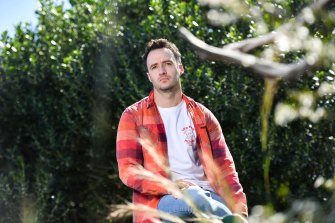
Whistleblower Justin Nixon.Credit:Joe Armao
Mr Nixon also decided to speak up after the stress of the job became too much and he quit.
“It was guilt that weighed on me having sold people … these shitty outcomes.”
The investigation uncovered the alleged use of staples in front of one patient’s ear after a facelift and in a tummy tuck procedure. Dr Lanzer and his doctors sometimes use staples rather than sutures, to save time during procedures.
Opinions were sought from three plastic surgeons, Professor Ashton, Dr Patrick Briggs and Dr Craig Rubinstein, who said they had never seen staples used in front of a patient’s ear.
“I’ve been doing facelifts for 30 years and I’ve never seen that before,” said Dr Briggs, while Dr Rubinstein was shocked that one of the staples had gone through the patient’s cartilage.

Staples used in cosmetic procedure.
“We never use staples on the face, in front of the ear. It’s such a delicate, cosmetically sensitive, important part of the face. It’s the part of the face that the community, their husbands, their lovers, their kids, their family, their friends, see every single day,” said Professor Ashton.
In a video response, Dr Lanzer said he uses a combination of sutures and staples. “As a skin specialist, I have a great passion to obtain the least scarring as possible,” he said. “The advantages of a staple is that it grabs the skin deep and takes the tension off the top layers. And there’s actually almost no redness and irritation, which is the cause of scarring. It’s important to remove the staples early.”
He said the staples are hidden under the skin and dissolve themselves.
‘Lanzer cares’
Ms Hewish, Mr Nixon and others know the mantra well: Dr Lanzer Cares. It is drummed into them and all staff through quizzes, internal audio messages and videos.
“I was just … in such excruciating agony that I could not think or feel. I just felt pain … All I could think is, ‘I’ve got to get through this.’
Former patient Jackie M
“For all you staff, remember, if somebody rings up, they’re not happy, they didn’t like the nurse, they didn’t like the doctor, they didn’t like the dressing … whatever the concern, it doesn’t matter what it is. There’s only one answer. If you say anything else, you just wasted your time, you didn’t do a good service. The answer is, ‘Hey, did you know that Dr Lanzer cares?’ ” he says in one message.
But patients spoken to as part of the investigation are deeply sceptical about the level of care they received in Dr Lanzer’s clinics.
Former patient Jackie (who requested her surname be removed for privacy reasons) had liposuction on her neck by a doctor – not Dr Lanzer – at one of the clinics in December 2020.
“Everything went wrong from the beginning. There were so many signs, but I had paid them and I didn’t know how to get out of it,” she said.
“He got me to lay down on the table and immediately started administering anaesthetic, which was extremely agonisingly painful. He didn’t warn me what he was about to do.
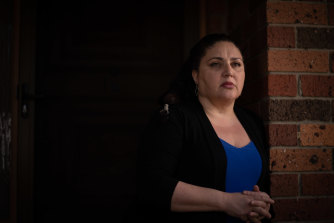
Former patient Jackie. Credit:Eddie Jim
“He didn’t talk at all, he just started injecting me with anaesthetic, an anaesthetic, and I began to cry out with pain and he just basically said, ‘Stop it! Stop it, you’re making it worse.’
“And I tried to breathe and tried to control my pain by breathing and like a low groan, and he got annoyed and said, ‘Don’t do that. Don’t make a noise. It’s … better if you just be quiet.’ ”
Once the liposuction began, the pain became worse.
“It was like having him punch, punch, punch my jawbone while he was doing it. I was crying in agony and he didn’t stop. And he just kept punching at the same place.
“I was just … in such excruciating agony that I could not think or feel. I just felt pain … All I could think is, ‘I’ve got to get through this.’ I couldn’t get up and run away … it was like you trusted someone to look after you and you were suddenly in a position you hadn’t seen coming.”
Jackie reported the doctor to the medical regulator AHPRA, which is investigating the case. In a statement, AHPRA said due to confidentiality restrictions it could not comment on whether an investigation was under way.
Jackie has spent thousands of dollars trying to get the nerve damage in her face fixed.
“[The doctor] had told me that I may have a slightly crooked smile that was temporary for a few weeks afterwards. This was not that. This was months and months of having a palsy of my mouth,” she said.
Jackie says the reason she chose the Lanzer clinic was because of the media hype. “They are validated by the media,” she said. “I scoured Google reviews looking for something negative and there were glowing reviews, and now, when I look back at it, those reviews don’t make sense.”
Responding to questions on pain management, Dr Lanzer said his patients were well-informed that there may be stinging and pain. “If the patient chooses to be awake, the vast majority of patients do not feel pain.” he said.
If there was some discomfort, they were looked after, he said.
‘It’s frankly dangerous’
The three plastic surgeons were shown photos of fridges at Dr Lanzer’s practices containing medications, fat and bottles of water.
“This looks like a normal, domestic fridge … [there] doesn’t look to be any temperature control monitoring. And there doesn’t seem to be any sterility,” said Professor Ashton.
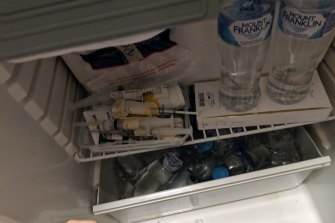
An untidy fridge.
“We have drugs which have been sealed with masking tape, sitting right next to drinking water in a commercial fridge. This, this is not even close to acceptable medical behaviour.”
Nurse Justin Nixon was shown footage of a storeroom in Dr Lanzer’s Sydney practice. He was able to identify surgical instruments and medical supplies sitting among the doctor’s clothes in a suitcase or nearby on the floor.
“You can also see that the tumescent fluids and various medications that will be administered into the patients are drawn up in sort of unsanitary conditions,” he said.
When shown the footage, plastic surgeon Dr Briggs said: “I’ve never anything like this. It’s staggering.”
Professor Ashton said: “There is no sterility, there is no concept of sterility, and how this is allowed to occur is … bewildering. I’ll call it out, it’s frankly dangerous.”
In Australia, state health departments are in charge of checking whether cosmetic surgery clinics are complying with regulations. In Victoria, the Department of Health gives registered day procedure hospitals such as Dr Lanzer’s six to eight weeks’ advance warning of an audit.
Registered day procedure hospitals must also comply with safety and quality standards, with inspections booked weeks in advance. This gives clinics such as Dr Lanzer’s plenty of time to get things in order.
“The auditor comes in and sees this lovely, empty, perfect theatre. But it’s because all the clutter that was in there is in people’s cars, fat that is in fridges that shouldn’t be stored in there is stored in nurses’ fridges at home before the audit,” said Ms Hewish.
Mr Nixon says he recalls nurses being asked to take human fat home and put it in their fridge until after an audit. “There’d be big bags, or shopping bags from Coles or Woolworths stuffed with syringes, or bags, liposuction bags full of fat,” he said.
Dr Lanzer denied any issues of sterility or hygiene in his clinics. “We have the highest standards of hygiene and safety. And therefore my infection rate over the last 30 years has been minuscule,” he said. “We’re audited every year by an infectious control nurse. And we’ve maintained that level of excellence since its inception … I do not think that there’s a surgeon in the world who could show a better safety record than I’ve done over the last 30 years … In my 30-year career, I’ve never had a single ruling or recommendation against me regarding my method of surgery or my patient care by any regulator.”
Mega-liposuction risks
Social media is ever-present in Dr Lanzer’s rooms. He films almost everything, with patients’ permission, including procedures in graphic detail, to share on a range of platforms.
One of the procedures Dr Lanzer spruiks is so-called mega-liposuction, where more than six litres of fat and fluids are removed from a patient in a single procedure. And sometimes he and his colleagues treat it like a reality TV show.
In one social media video, Dr Lanzer and his colleague count how many litres of fat have been removed in one procedure. “The patient says six litres … I said 10. Let’s have a look. Two, four, five, six, seven, and two over here is eight, nine, 10 litres! Ten litres!” Dr Lanzer says.
Professor Ashton says “this sort of, macho bragging about how much fluid … about how much fat he can remove shows a complete disconnect from the doctor-patient relationship”.
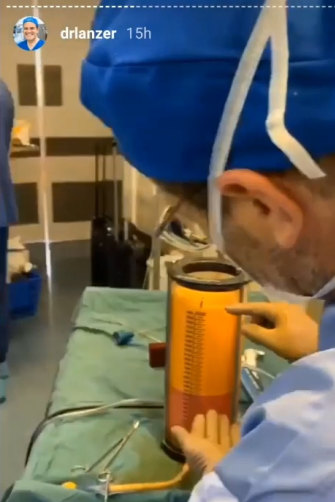
Social media video of Dr Daniel Lanzer and colleagues counting up litres of fat removed in a liposuction procedure. Credit:Instagram
Internationally recognised US plastic surgeon Dr Lawrence Gray says the potential dangers of mega-liposuction have been recognised for some time.
Responding to questions about the dangers of removing large amounts of fat, Dr Lanzer referred to himself as a pioneer of mega-liposuction.
“There are very few surgeons in the world who use this method. I’ve performed literally thousands of cases over the last 30 years, without a single serious complication,” he said. “Large volumes are removed in a Sydney private hospital or in stages in outpatient clinic.
“I’ve written a chapter in the book of liposuction about how to avoid complications. I’ve spoken in America about my method of mega-liposuction at both the American Academy of Dermatology and the American academy of cosmetic surgeons. Painful lipidemia and obesity are serious issues. And there’s a safe, life-changing operation in the hands of the right person. And I’m proud of it.”
‘Absolutely diabolical standards’
Nurse Kathy Hubble ended up in Gosford Hospital for almost a week in November 2018 with a full-blown cellulitis infection a few days after liposuction of her legs and abdomen in Dr Lanzer’s Sydney clinic.
“His standards were sub-poor. They were absolutely diabolical,” she said. “And as an experienced theatre nurse, I could tell that he didn’t meet any of the standards or the guidelines for a procedure room. Every alarm bell in my head was ringing. I actually thought it was a change room when I first walked into it. It was so tiny … The surgical equipment was open and had a fan blowing over it, which was risky for infection.”
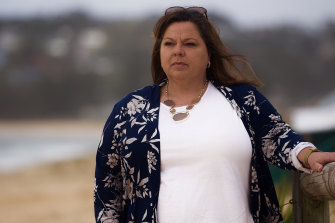
Former patient Kathy Hubble.
Ms Hubble says she had the procedure over two days and then the “agony” set in. Her partner drove her to Gosford Hospital.
“A couple of doctors look at me and they were absolutely horrified. And they notified Dr Lanzer that I was in hospital. And he then started ringing my mobile phone. He was trying to convince me to leave the hospital and go back to the clinic in Sydney, or he was going to send one of his doctors up to get me.”
Dr Lanzer refunded Ms Hubble the cost of her surgery and asked her to sign a confidentiality agreement, which she refused. Dr Lanzer’s daughter told her in a message that the refund was because he felt “sorry for you”. She accused Ms Hubble of not taking antibiotics after surgery, working full-time and not giving Dr Lanzer the opportunity to treat her post-procedure.
Ms Hubble denied the allegations, saying she wasn’t working at the time, had taken antibiotics “diligently” and she denied the offer of treatment because she was in hospital.
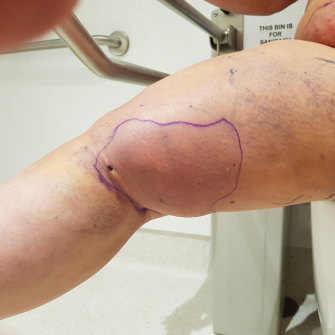
Image of Kathy Hubble when she was diagnosed with cellulitis shortly after liposuction.
Dr Lanzer said patients are adequately warned about infections. “So the patient knew that it’s a risk, even though it’s one in a thousand, it’s so rare,” he said. “After liposuction, you see, they develop what’s called seromas, it’s a type of fluid, which can be easily drained … with a needle.”
He said other doctors just give antibiotics.He said he called this patient “many times because I cared about her as a person. And I cared about her getting the best treatment.” He denied insisting on a non-disclosure agreement but added: “I have a list of a few-hundred unhappy patients from other surgeons who came to me for revision or advice. Every surgeon asked for an NDA when they refunded money.”
Donna’s story
Donna Patterson has spent 21 years living with the mental and physical scars of a breast reduction she says she now believes she should never have had.
She sought the procedure not for cosmetic reasons but to cope with congenital back pain, or scoliosis. She was told reducing her breasts would help alleviate this problem.

Donna Patterson has spent 21 years living with the mental and physical scars of a breast reduction.Credit:Aaron Smith/ABC
She had seen Dr Lanzer in the media promoting a ground-breaking breast liposuction procedure that he said would reduce the recovery time of the more traditional mammaplasty surgery, which is a more invasive surgery.
“I thought, ‘Oh, wow. It’s promising a three-day turnaround, back to work in three days’,” she said.
The operation left her in excruciating pain for two years and she ultimately had to undergo corrective surgery.
“He ruined a very long time in my life. He caused me extreme pain.”
She sued Dr Lanzer in 2002 and the court found he was either negligent towards Ms Patterson or had breached his contract with her, and ordered him to pay damages. Dr Lanzer appealed but lost.
Dr Lanzer said the dispute with Ms Patterson went to the medical practitioner board of Australia, which ruled in his favour. “I’m happy to advise that my method now is an accepted surgical option for breast reduction all around the world.”
Medication risks
There is also evidence the practice may have used medication that was out of date.
A message from a senior nurse to staff in February 2020 says: “… Please don’t use new stock until the old stock is used. We have stock that expired in Nov and Dec 2019 that needs to be used first.”
Plastic surgeon Dr Rubinstein said drugs had an expiry date for a reason and they should be discarded when it passed.
The investigation has also obtained messages that suggest Dr Lanzer has signed blank prescriptions for nurses to later fill out.
One senior nurse in Dr Lanzer’s clinics wrote: “To nurses that are working between Xmas and start-up nxt year. DL has left some signed scripts for emergencies. They will be kept in locked DD cubboard [sic].”
The DL refers to Daniel Lanzer. The DD cupboard refers to drugs of dependence.
In his statement, Dr Lanzer said: “We do not use blank scripts. I think you’ve been given false information.
“In the example you mentioned, see antibiotics are not a schedule, a drug, which is actually the classification for opioid painkillers. Our audit practice policy is to write scripts according to the guidelines of the Pharmaceutical Society of Australia.”
‘Never, ever, ever, ever own up to anything’
The joint investigation tried to find out how many patients have had bad outcomes at Dr Lanzer’s clinics – it wasn’t easy.
A freedom of information request revealed that two patients from Dr Lanzer’s Melbourne practice were rushed to hospital this year by ambulance. But there’s no way of finding out how many admitted themselves, like Kathy Hubble did, or were driven to hospital by staff such as Justin Nixon.
“Patients that needed to be transported to hospital via ambulance, he would have me drive them, so there’s no ambulance record of transport,” Mr Nixon said.
One audio message illustrates Dr Lanzer’s reluctance to have a patient go to a doctor outside the clinic.
“And I never, ever, ever, ever wanna hear any staff sending anybody to a GP. You page me first, OK? We can handle everything. Sending to a GP is the worst possible thing you can do, or to a hospital, never, ever, ever … and it always creates problems,” he says in the recording.
Then there is Dr Lanzer’s policy on surgical complications to “never, ever, ever, not slightly ever, ever, ever, ever, ever, ever, EVER admit to a patient that something’s bad or wrong … Never, ever, ever, ever own up to anything.”
Professor Ashton says he is appalled by the message to staff. “It’s dangerous,” he said.
In response, Dr Lanzer says his doctors are best suited to deal with any complications arising from surgeries.
“I have a top general physician, who’s been an adviser to our practice for decades and can admit patients to hospital in the extreme, rare occasion. If it’s required, you see the procedures I perform [are] very specialised and not something that other doctors are familiar with and it could really compromise their results.”
Professor Ashton said the problem in Australia is that patients of cosmetic surgery who present to an emergency department away from the facility are recorded as someone who walked through the front door.
“I can tell you that it’s all-pervasive, it’s grossly under-reported.”
He says the problems and risks of an under-regulated cosmetic surgery industry in Australia are widespread.
“Dr. Lanzer is the tip of the iceberg.”
The Morning Edition newsletter is our guide to the day’s most important and interesting stories, analysis and insights. Sign up here.








